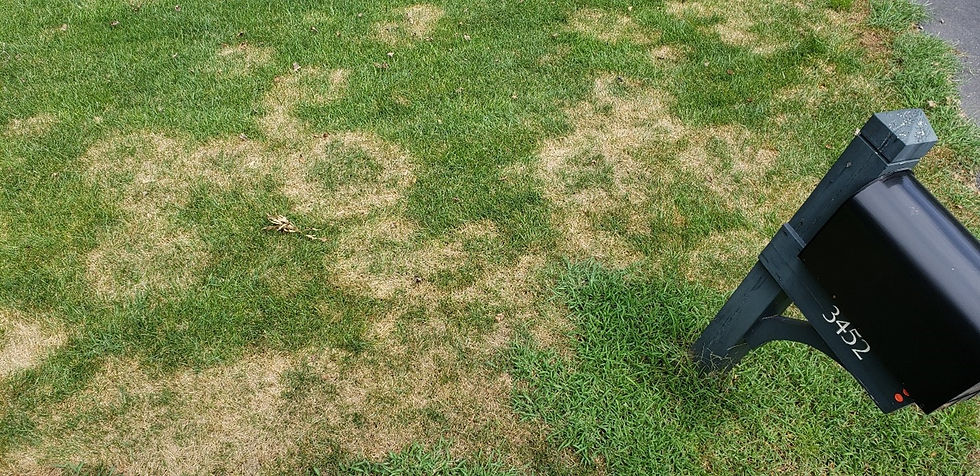There’s a Fungus Amung’ Us!!
- greenlawnvirginia
- Jun 22, 2022
- 4 min read


The above pictures are of brown patch fungus in a Forest Lakes North lawn in Charlottesville.
It’s the time of year where the kids are out of school, the bags are packed for the beach and the 3 “H’s” are back in the forecast; “Hazy, Hot and Humid”. In other words, it’s fungus season. There are many different types of lawn diseases in Central Virginia, although, our most damaging summer time fungus is Brown Patch. And now is the time to treat for it.
Brown patch, caused by the Rhizoctonia species fungus, is the most prolific disease occurring in our fescue lawns. It appears as yellow or brown circular areas that vary in size but average the size of a dinnerplate. Generally, brown patch will not cause permanent damage to the turf but if left unchecked, may very well wipe out whole sections of turf.
How does it start? As with most types of lawn fungus, brown patch is present in all lawns throughout our area. It lives in the soil and when the temperatures and humidity reach a certain point, the fungus starts to breed and spread. For brown patch a reliable equation is L + H = B. In this equation “L” would be the average night time low, “H” would be the average humidity and “B” is brown patch fungus. When these numbers are added together and B = 140 or greater, the probability of having brown patch is very high. For example, if L=63 and H=82 then B=145; time for Brown Patch! This is a very reliable equation for predicting the emergence of this disease.
Though temperature and humidity are major factors in the development of brown patch, there are several other contributing factors that may compound the likelihood of an outbreak. The blades of grass must be continuously wet for extended periods of time (10 hours or more) for the brown patch fungus to infect the plant. Poor drainage due to compacted soil, lack of air movement, shade, cloudy weather, dew, over-watering, and watering in late afternoon or evening and afternoon/evening thunderstorms may leave lawns wet for over 12 hours. Also, lawns that are over fertilized, especially with high nitrogen fertilizers, in late spring and summer will have the potential for severe brown patch that may even lead to catastrophic failure of almost all turf areas. Add all of these factors with soils high in phosphorous and your lawn will be in big trouble.
So, what can be done? Actually, some things are totally out of your control. You cannot control the weather so let’s concentrate on the factors that you can. Manually control and limit watering. It is always best to water the lawn manually and early in the morning when it is already wet from dew and water only when needed. It is actually best to water as soon as the grass starts to wilt. WILT? Yes, grass does wilt, although, not as most people would think. Instead of bowing over and “hanging its head” grass wilts by closing in on itself, much like closing a book. Just remember, this method does require close daily monitoring of the grass for best results. Another practice is to never over apply nitrogen to the lawn in the spring and summer. The lawn should be fed once in March or early April with no more than ½ pound of nitrogen per 1000 square feet of turf. No additional fertilizers should be applied to the lawn until the late summer. Instead of applying additional fertilizers in the late spring and summer, add organics. Compost, liquid carbons, concentrated liquid humic acid extracts and other modern organic extracts will feed and promote the good bacteria and fungus in the soil. The good types of fungus will out compete the bad fungus.
Moreover, by promoting the proper soil ecology, the soil will be able to more easily release phosphorous and potassium molecules so that the grass may uptake these nutrients. By “mining out” these nutrients the turf becomes healthier and will have an increased immunity to disease. The use of fungicides will also help tremendously in not only curing the lawn of an outbreak of brown patch but may also prevent the problem before it occurs. This does NOT make the use of fungicides a silver bullet, though. Just as antibiotics should be used on a limited basis for people, fungicides should be limited on lawns, and for the same reason; creating resistance. Fungicides should be changed up year to year and application to application to help prevent resistant strains of fungus. Planting fungus resistant grasses will also help in controlling this disease. High-end Kentucky 31 (90% germination rate, 0.00% weed seeds and 0.01% other crop seeds) is the most fungus resistant grass to plant.
A Turf Type Tall Fescue, tri-seed blend is the second most resistant. These grasses should be planted in the fall when the lawn is aerated. Which brings up another very important cultural practice in reducing the probability of a fungal outbreak, core aeration. Core aeration will relieve soil compaction thus allowing for improved movement of air and water through the soil. The soil will be able to drain more easily and can “breathe” better. This is not only important in preventing lawn diseases, it is also crucial to root development and overall health of the turf. Applying all of these best practices to your lawn will not only greatly reduce fungal issues, combined they will help you to achieve the very best lawn possible.
If you are tired of battling fungus, having brown dead aeras in your lawn, want more information on turf care or would like to explore how American Green can help you get a lawn you’ll love, call or e-mail us today. Quotes and consultations are free. We look forward to hearing from you. 540-406-1766 AmericanGreenVa@gmail.com




Comments